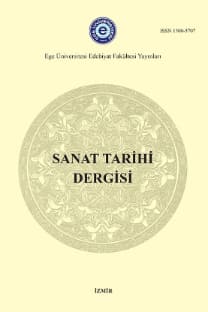Çizgi Roman Biçiminde Mimari Temsiller: Archigram
Archigram, mimari temsil, çizgi roman, kitle kültürü, modern sanat, popüler kültür
Architectural Representations in the Form of Comic: Archigram
Archigram, architectural representation, comics, mass culture, modern art,
___
- Aksu, A., Uludağ, Z., & Çağlar, N. (2008). Sanat, Kent ve Mimarlık Eleştirisi için Ortak Bir Tema: Kent Kolajları. Gazi Üniversitesi Mühendislik Mimarlık Fakültesi Dergisi, 23, 741-748.
- Alp, K. Ö. (2013). Sanatın Temsili ve Postmodern Sanatta Temsil. Art-e Süleyman Demirel Üniversitesi Güzel Sanatlar Fakültesi Hakemli Dergisi, 12, 40-61.
- Antmen, A. (2008). 20. Yüzyıl Batı Sanatında Akımlar*. İstanbul: Sel Yayıncılık.
- Beathy, B. (2017). Sanat Karşısında Çizgi Roman. (N. Elhüseyni, Çev.) İstanbul: Yapı Kredi Yayınları.
- Benjamin, W. (2001). Teknik Olarak Yeniden Üretilebilirlik Çağında Sanat Yapıtı. In Pasajlar (A. Cemal, Çev.). İstanbul: YKY Yayınları.
- Cook, P. (2020, 05 11). Peter Cook discusses the rise of Archigram in the 1960s in exclusive Dezeen interview for VDF, Dezeen: https://www.dezeen.com/2020/05/11/archigram-origins-peter-cook-video-interview-vdf/ [Erişim: 10.05.2021]
- Cook, S. P. (2013). Amazing Archigram! (C. Oloriz, & K. Rus, Interviewers), https://www.mascontext.com/issues/20-narrative-winter-13/amazing-archigram/ [Erişim: 14.06.2021]
- Danto, A. C. (2018). Andy Warhol. (S. Sertabiboğlu, Çev.) İstanbul: Ayrıntı Yayınları.
- Gompertz, W. (2015). Pardon Neye Bakmıştınız? (S. Evren, Çev.) İstanbul: Yapı Kredi Yayınları.
- Gürer, T. K. (2004, 01 12). Bir Paradigma Olarak Mimari Temsilin İncelenmesi. Yayımlanmış Doktora Tezi, Fen Bilimleri Enstitüsü, İstanbul. http://hdl.handle.net/11527/10340
- Gürer, T. K., & Yücel, A. (2005). Bir paradigma olarak mimari temsilin incelenmesi . itüdergisi/a, 84-96.
- Hejduk, R. (2006). Beyond Architecture: Technology, Freedom, and Play. In R. Cheng, & P. J. Patrick J Tripeny, Getting Real: Design, Ethos, NowHejduk, R. (2006). Beyond Architecture: Technology, Freedom, and Play. R. Cheng, & P. J. Patrick J Tripeny içinde, Getting Real: Design, Ethos, Now. Washington DC: Association of Collegiate Schools of Architecture, 227-239
- Hickman, M. (2020). ArchDaily: https://www.archdaily.com/951207/after-coronavirus-delays-m-plus-launches-archigram-cities-series-in-a-hybrid-format [Erişim:15.06.2022]
- Hobson, B. (2020). https://www.dezeen.com/2020/05/14/archigram-monte-carlo-dennis-crompton-video-interview-vdf/ [Erişim:18.06.2022]
- Huxtable, A. L. (1998). Architecture’s Dream Team. The Wall Street Journal. https://www.wsj.com/articles/SB893299276589124500 [Erişim:18.06.2022]
- McCloud, S. (2018). Görünmez Sanat Çizgi Romanı Anlamak. (M. Ülgen, Çev.) İstanbul: Sırtlan.
- McCloud, S. (2021). Çizgi Romanın Yeniden Keşfi. (S. E. Yavuz, Çev.) İstanbul: Sırtlan Kitap.
- Museum of Modern Art (MoMA), 1972 https://www.moma.org/momaorg/shared/pdfs/docs/press_archives/4800/releases/MOMA_1972_0029_26.pdf [Erişim:11.06.2021]
- Özkuş, B. (2005). “Renkli Rüyalar Görmek”: Archigram. Mimar.ist, 84-86.
- Özkuş, B. Y. (2006, 10 13). Archıgram: Tekno-topya. Yayımlanmış Yüksek Lisans Tezi, İstanbul Teknik Üniversitesi Fen Bilimleri Enstütüsü, İstanbul. http://hdl.handle.net/11527/3257
- Polatkan, A. H. (2006). Bir Anksiyete Ortamı Olarak Modern Mimarlıkta Brütalizm ve Brütalist Çevre Üzerine Sorular. Betonart, 9.
- Rousseau, B. (2008, 02 01). Sir Peter Cook ile Söyleşi. https://v3.arkitera.com/h24466-sir-peter-cook-ile-soylesi.html#:~:text=Cook%2C%20%C5%9Fu%20anda%202012%20Olimpiyat,dolay%C4%B1%20%E2%80%9CSir%E2%80%9D%20%C3%BCnvan%C4%B1yla%20%C3%B6d%C3%BCllendirildi. [Erişim: 16.05.2021]
- Sadler, S. (2005). Archigram Architecture Without Architecture. Londra, Cambridge, England: The MIT Press.
- Sadler, S. (2011). Archigram (act. 1961-1974). Oxford Dictionary National Biography. doi:https://doi.org/10.1093/ref:odnb/101273
- Savaşır, G. (2018). Yeni Brütalizm’in Robin Hood’undan İmdat Sinyali. Arredamento Mimarlık, 84-89.
- Tanyeli, U. (2017). Yıkarak Yapmak Anarşist Bir Mimarlık Kuramı İçin Altlık. İstanbul: Metis Yayınları.
- Team 10 Meetings. Team 10 Online: http://www.team10online.org/ [Erişim Tarihi:19.06.2022]
- Tristan Tzara ve Dada Manifestosu. (2016, 04 16). e-Skop: https://www.e-skop.com/skopbulten/dadanin-100-yili-tristan-tzara-ve-dada-manifestosu/2915 [Erişim: 01.06.2021]
- Walsh, N. P. (2019). Archdaily. https://www.archdaily.com/910328/archigrams-entire-archive-purchased-by-m-plus-museum-in-hong-kong [Erişim: 11.06.2021]
- ISSN: 1300-5707
- Yayın Aralığı: 2
- Başlangıç: 1982
- Yayıncı: Ege Üniversitesi, Edebiyat Fakültesi
Nevşehirli Damat İbrâhim Paşa’nın Külliyeleri Üzerine Bir Değerlendirme
19. Yüzyıl İstanbul Minarelerinin Konum, Form, Malzeme ve Süsleme Özellikleri
Zeynep ÖZKAN TEKNECİ, Bozkurt ERSOY
Ürgüp Temenni Mahallesi Dokusu, Yapıları ve Korunma Sorunları
Sanat Eleştirisinin Edebi Eleştiriden Kopuşu ve 18. Yüzyılda Eleştiri Ölçekleri
İzmir Agios Ioannis Teologos Kilisesi Çeşmesi
Askeri Silah ve Kıyafet Tasvirlerindeki Pseudo-Kufîlerin Değerlendirilmesi
Fatih (İstanbul), Atikali Mahallesi’ndeki Bazı Çeşmelerin İhyası
Pari MALEKZADEH BAROUGH, Sevgi PARLAK
Ülkü Dergisi Kapak Tasarımları: Cumhuriyet İdeolojisinin Görsel Temsili
Suna AYDIN ALTAY, Esra ÖZKAN KOÇ
